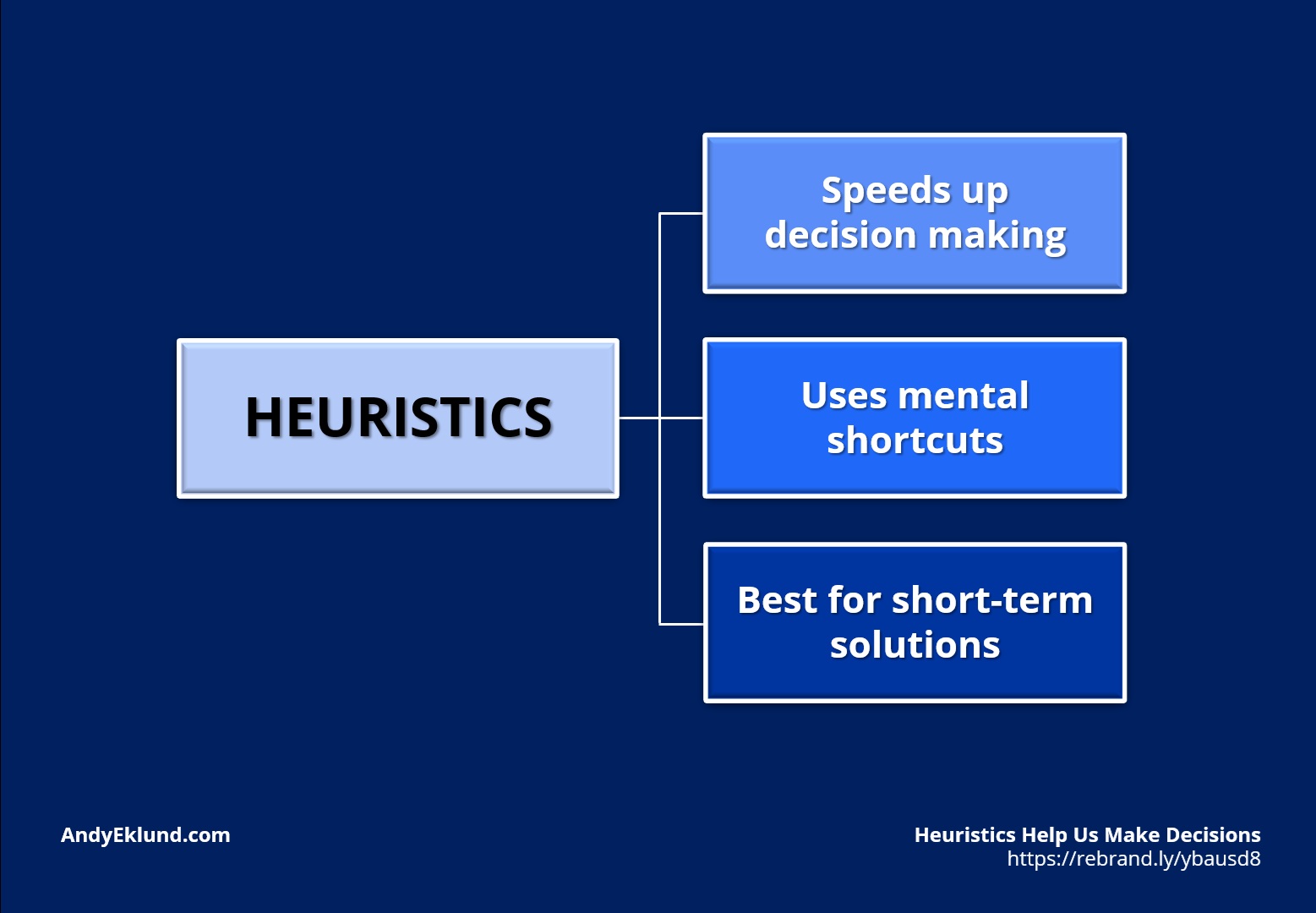If you need to make a quick decision, there’s a good chance you’ll rely on heuristics.
It’s a fancy word for a very simple idea created not so long ago. They were first mentioned in the 2011 paper “Heuristic Decision Making” by German psychologist Gerd Gigerenzer. Its meaning comes from the Greek word heuriskein, meaning “to discover” or to “find out.”
In short, they are a way of thinking, or in this case, they are a type of fast thinking. Heuristics are often based on intuition.
If you want it, here’s a specific definition
Heuristics are a type of “mental shortcut” which allows allow people to solve problems and make judgments quickly and efficiently.
Think of heuristics as a way to help shorten decision-making time. And, by speeding up the decision, they allow us to be more productive as we aren’t constantly stopping to think about what to do (next).
Common Heuristics We All Use
Below are some of the most common types of heuristics you may rely upon to make a decision.
At the same time …
It’s less important to memorise the specific types of heuristics listed below. Rather, it’s more important to know what you should do to make a better, more accurate or longer lasting decision. Like virtually everything in life, each heuristic given below as an example has both benefits vs. drawbacks.
Anchoring is when you make a decision based on the first piece of information you’re given. (Remember, always gather at least two things. If you only have one, you cannot compare and contrast to see which is preferable.)
Availability is when you make a decision based on whatever is quick to mind, such as how you recently handled another problem or created a solution, not necessarily at the distinctiveness of the current situation.
Familiarity is making a decision on something you have experienced many times in the past. It’s often called “routine.”
Mood is incredibly common: making a decision based purely on an emotion, or worse, an emotion you probably couldn’t specifically articulate. (For example, frustration and annoyance sound the same but are completely difference.)
This heuristic is also a good time to remind everyone, myself included the following truth. Do not make a permanent decision based on a temporary situation.
Representativeness is a comforting stereotype. For example, a person you are dealing with in a specific situation is a soft-spoken old person. In fact, they remind you of your grandfather. Of course, you trust your grandfather – thus, you trust this new person without any real proof or action. You only use what “represent” to you.
Scarcity is making a decision because the situation or the solution are either rare or unusual. For example, how many of us have bought something because someone said “Limited time only”? You leapt to a decision even though you had no real grasp on timing or availability.
Trial-and-error is incredibly common. You make a decision but … you adjust that decision when the solution didn’t work. Or, you might be able to improve it. Or, you change your plan after learning new information. It’s an effective and long-term way to learn, but it’s also very messy. You make lots of mistakes before becoming a more effective decision-maker.
Key Points to Remember
Simply being aware is a good start. Just knowing what heuristics are is a good way to realise if your thinking is faulty.
There’s nothing wrong with being skeptical. Don’t automaticallyl trust any piece of information without asking yourself: Is this piece of information true? How do I know? Who says? Here’s a quick list of how to decide if a piece of informtion is “good”.
Skepticism isn’t negativity. Don’t confuse negativity and criticism. Skepticism is critical (specific and constructive) vs negative (which is vague and destructive.)
Seek out diverse perspectives. Look for people who are different than you and think different than you. Don’t just except another person’s negativity without addressing it. For example, if someone is excessively critical about a certain aspect, ask: “Is there anything good about it?” This is also a good idea for people who excessively positive: “Is there anything about it that could be improved?”
Don’t just research to prove yourself right. Try to prove yourself wrong. Otherwise, it’s biased thinking.
Use traditional frameworks for decision-making. These are can range from complex frameworks (like a root cause analysis) to simple processes (like a pros and cons list or similar aka SWOT analysis.)
Effective leaders are reflective leaders. Build reflection into every important thought process, whether that’s before, during or after the decision.
Any other thoughts, opinions or examples of heuristics that you’ve used? Please add your comments below.



No comment yet, add your voice below!